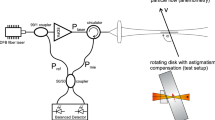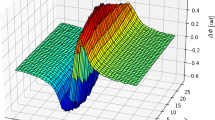Abstract
A laser Doppler anemometer with a laser diode as the light source, has several advantages: i.e., low power consumption, compactness, and low cost. In order to be fully benefitted by these favorable characteristics, the measurement uncertainty, associated with wavefront distortion in the measuring volume, should be minimized. Furthermore, proper attention should be given to system misalignment caused by external perturbations, such as thermal expansion of the diode-collimator assembly. These considerations lead to a computational procedure for optimizing the layout of the semiconductor LDA system. Calculations are based on a generalized relation for fringe non-uniformity combined with a simulation model for the anemometry system. For this purpose, the optical field of a laser diode is described satisfactorily as a product of a Gaussian and a truncated Lorentzian distribution. The influence of various design parameters is examined by means of an extensive computational study as well as experimental evaluation involving precise scanning of the measuring volume. The performance is improved by employing a small focal length collimator and a large focal length front lens. For measurement of turbulence intensities smaller than 1%, it may become necessary to collect the signals in the side scatter and to use a frequency-domain signal processor. For such an application, temperature control may also be necessary, but it should be applied to the entire diode-collimator assembly and not just to the laser diode as suggested in previous publications.
Similar content being viewed by others
Abbreviations
- A n :
-
amplitude of the nth laser beam in the laboratory coordinates
- A′ n(t):
-
instantaneous amplitude of the nth beam relative to the moving particle
- A xn :
-
amplitude function along x n-axis
- A yn :
-
amplitude function along y n-axis
- f :
-
arbitrary frequency in the signal spectrum
- f 0n :
-
frequency of the nth beam in the laboratory coordi nates
- f 1 :
-
focal length of the collimating lens
- f 2 :
-
focal length of the front lens
- f d :
-
nominal signal frequency
- f′ d :
-
instantaneous signal frequency
- ′f d :
-
measured signal frequency in time-domain
- ′f d :
-
frequency at the peak of the signal spectrum
- i n :
-
unit vector along x n-axis
- j n :
-
unit vector along y n-axis
- k n :
-
unit vector along z n-axis
- k :
-
wavenumber of the laser beams
- n :
-
subscript denoting the beam number (1 or 2)
- P s(t):
-
instantaneous power of the signal
- P sf(t):
-
instantaneous power of the filtered signal
- ′ d ′ :
-
instantaneous signal pedestal
- R n :
-
radius of curvature of the Gaussian distribution in nth laser beam
- R Ln :
-
radius of curvature of the Gaussian distribution in nth laser beam, immediately after the front lens
- t :
-
time
- t 1, t 2 :
-
signal cut-off points in time-domain
- u :
-
particle velocity along x-axis
- u n :
-
x-component of the particle velocity relative to the nth beam
- U n :
-
optical field of the nth beam
- U′(t):
-
combined optical field of both the beams relative to the moving particle
- U′ n(t):
-
optical field of the nth beam relative to the moving particle
- v :
-
particle velocity along y-axis
- v n :
-
y-component of the particle velocity relative to the nth beam
- V n :
-
velocity vector in the coordinates of the nth beam
- V(t):
-
instantaneous signal visibility
- w :
-
particle velocity along z-axis
- w n :
-
z-component of the particle velocity relative to the nth beam
- W n :
-
half-waist of the Gaussian distribution for the nth beam
- W Ln :
-
half-waist of the Gaussian distribution at the front lens for the nth beam
- (x,y, z):
-
global coordinates for a dual-beam system
- (x 0n, y0n, z0n):
-
initial particle location in the coordinate system of the nth beam
- X 0n :
-
initial position vector of the particle in the coordinate system of the nth beam
- (x n, yn, zn):
-
particle location in the coordinate system of the nth beam
- X n :
-
position vector of the particle in the coordinate system of the nth beam
- Δx :
-
distance between signal cut-off points in timedomain
- ζζ n :
-
transverse coordinate of the nth beam along which the field distribution is Gaussian
- ηn :
-
transverse coordinate of the nth beam along which the field distribution is Lorentzian
- θ :
-
half-angle between the laser beams
- λ :
-
wavelength of the laser light
- Πs(f):
-
Fourier transform of the signal
- φ 0 :
-
initial phase of the signal
- φ 0n :
-
phase of the nth beam at the initial particle location
- φ T0n :
-
transverse phase of the nth beam at the initial particle location
- φ Tn :
-
transverse phase of the nth beam
- φ′ Tn(t):
-
transverse phase of the nth beam relative to the moving particle
- φφ xn :
-
phase function along x n-axis
- φφ yn :
-
phase function along y n-axis
- φφ ζn :
-
phase function along ζ n-axis
- φη nn :
-
phase function along η n-axis
- ωω 0n :
-
circular frequency of the nth light beam in the laboratory coordinates
- ω′ω ′ on :
-
instantaneous circular frequency of the nth beam relative to the particle
- ▽ n :
-
gradient operator in the coordinate system of the nth beam
References
Adrian, R. J.; Orloff, K. L. 1977: Laser anemometer signals: visibility characteristics and application to particle sizing. Appl. Opt. 16, 677–684
Brown, R. G. W.; Burnett, J. G.; Hackney, N. 1988: A miniature, battery operated laser Doppler anemometer. 4th Int. Symp. Appl. Laser Anemometry Fluid Mech. Lisbon, 3.4
Damp, S. 1988: Battery-driven miniature LDA-system with semiconductor laser diode. 4th Int. Symp. Appl. Laser Anemometry Fluid Mech. Lisbon, 5.4
Dopheide, D.; Faber, M.; Reim, G.; Taux, G. 1988: Laser and avalanche diodes for velocity measurement by laser Doppler anemometry. Exp. Fluids 6, 289–297
Durst, F.; Stevenson, W. H. 1979: Influence of Gaussian beam properties on laser Doppler signals. Appl. Opt. 18, 516–524
Durst, F.; Bopp, S.; Brunn, P. O.; Holweg, H.; Weber, H. 1988: An optical sensor for accurate, small volume rate measurements. Sensor 88 Nürnberg, Congr. Proc. pp. 161–185
Hanson, S. 1973: Broadening of measured frequency spectrum in a differential laser anemometer due to interference plane gradients. J. Phys. D6, 164–171
Li, Y.; Wolf, E. 1981: Focal shifts in diffracted converging spherical waves. Opt. Commun. 39, 211–215
Naqwi, A.; Durst, F. 1990: Focusing of a diode laser beam: a simple mathematical model. Appl. Opt. 29, 1780–1785
Paoli, T. L. 1977: Waveguiding in a Stripe-Geometry Junction Laser. IEEE J. Quantum Electron. 13, 662–668
Author information
Authors and Affiliations
Rights and permissions
About this article
Cite this article
Durst, F., Müller, R. & Naqwi, A. Measurement accuracy of semiconductor LDA systems. Experiments in Fluids 10, 125–137 (1990). https://doi.org/10.1007/BF00215021
Received:
Issue Date:
DOI: https://doi.org/10.1007/BF00215021




